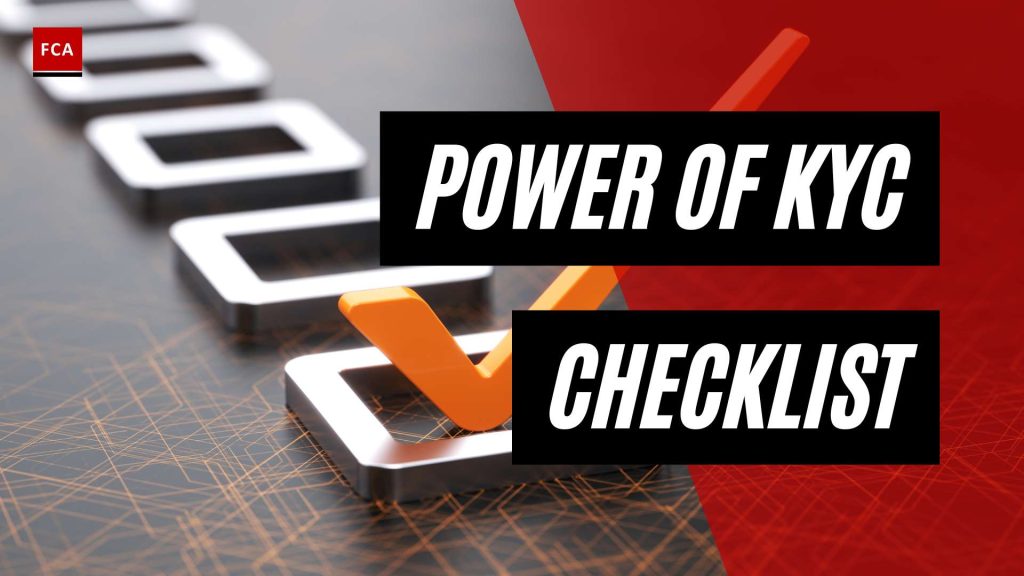Essential Elements of KYC Compliance
Knowing your customer is not merely a business strategy but also a regulatory requirement to combat financial crimes. The process of verifying customer identities and assessing their risk profiles, commonly known as Know Your Customer (KYC) compliance, is a cornerstone of effective anti-money laundering (AML) programs. This section will explore the role of KYC in an AML strategy and the consequences of KYC non-compliance.
Role of KYC in AML Strategy
KYC compliance is crucial for identifying and preventing financial crimes and ensuring adherence to AML regulations monitored by government agencies. It involves collecting customer information, verifying customer identities during onboarding, and ensuring that these verifications are part of an ongoing process to prevent financial crimes. This ongoing process includes customer identification, customer due diligence, and ongoing monitoring (Jumio).
A well-structured KYC program is a critical component of an effective Anti-Money Laundering (AML) program, ensuring that organizations are safeguarded from financial crimes and illegal activities. Moreover, enhanced due diligence (EDD) should be conducted for customers posing higher risks, including politically exposed persons (PEPs) and customers from high-risk jurisdictions.
Consequences of KYC Non-Compliance
Non-compliance with KYC regulations can lead to severe penalties and reputational damage (Jumio). Financial institutions and service providers are required to adhere to KYC and AML regulations to prevent financial crimes such as drug trafficking, money laundering, and terrorist financing.
Without a well-designed KYC process, organizations risk non-compliance with government regulations, potentially leading to severe penalties and reputational harm (Jumio). Therefore, having a comprehensive AML compliance checklist that includes KYC compliance steps is essential in mitigating these risks.
Understanding the critical role of KYC in an AML strategy and the potential consequences of non-compliance is crucial for achieving compliance success. As KYC requirements continue to evolve, organizations must stay informed and adapt their compliance processes accordingly to prevent financial crimes and ensure regulatory compliance.
KYC Processes Explained
Know Your Customer (KYC) compliance is a crucial aspect of any effective anti-money laundering strategy. It involves collecting customer information, verifying their identities during the onboarding process, and maintaining an ongoing process to ensure compliance with regulations (Jumio). In essence, it is a three-step process that includes the Customer Identification Programme (CIP), Customer Due Diligence (CDD), and ongoing monitoring (FDM Group).
Customer Identification Programme
The first step in the ‘know your customer checklist’ is the Customer Identification Programme (CIP). This involves collecting essential customer information for identity verification. The objective is to ensure that the customer is who they claim to be, and to prevent businesses from becoming a platform for illicit activities such as money laundering and fraud.
The CIP typically involves the collection of information such as:
- Full Name
- Date of Birth
- Address
- Identification number (such as a Driver’s License, Passport, or Social Security Number)
This information is then verified using reliable, independent sources. Any discrepancies or red flags must be resolved before a customer can be onboarded.
Customer Due Diligence
The next step in the KYC process is Customer Due Diligence (CDD). This involves an in-depth examination of customer activities and risk assessment. The purpose of CDD is to understand the nature of the customer’s activities and determine if they pose a risk for illegal activities.
The CDD process typically includes:
- Identifying the customer’s source of funds
- Understanding the nature and purpose of the customer’s relationships
- Assessing the level of risk associated with the customer
Based on the risk level, an Enhanced Due Diligence process may be required for high-risk customers. For more information on the CDD process, refer to our customer due diligence checklist.
Ongoing Monitoring
Lastly, ongoing monitoring ensures businesses stay vigilant to changes in customer behavior and emerging risks. This includes monitoring transactions, updating customer records, and re-assessing risk levels.
Ongoing monitoring helps businesses:
- Identify suspicious activities or transactions
- Spot changes in customer behavior that may indicate a change in risk level
- Update customer information to ensure it’s up-to-date and accurate
The combination of CIP, CDD, and ongoing monitoring forms the foundation of an effective AML compliance program. While these processes may vary across industries, they are vital in ensuring regulatory compliance and protecting businesses from financial crime. For a comprehensive guide on the steps involved, refer to our AML compliance checklist.
Deep-Dive into Enhanced Due Diligence
The effectiveness of a Know Your Customer checklist relies heavily on the ability of an organization to conduct comprehensive Enhanced Due Diligence (EDD). This step is crucial in identifying and mitigating potential risks associated with high-risk customers.
EDD for High-Risk Customers
Enhanced Due Diligence (EDD) is a vital process in the AML compliance program and must be conducted for customers posing higher risks, including Politically Exposed Persons (PEPs) and customers from high-risk jurisdictions.
EDD involves a deeper examination of a customer’s profile to understand the nature of their transactions and assess potential risks. This process is not a one-time activity and requires ongoing monitoring and periodic reviews to ensure compliance.
The EDD process should include:
- Understanding the customer’s source of wealth and funds.
- Reviewing the customer’s business and occupation.
- Analyzing the customer’s transaction behavior.
- Identifying and assessing any risk factors associated with the customer.
Without a well-designed EDD process, organizations risk non-compliance with government regulations, leading to severe penalties and damage to their reputation (Jumio).
Importance of PEP Screening
Politically Exposed Persons (PEP) screening is another crucial aspect of the EDD process. The Know Your Customer checklist must include PEP screening to identify relationships with individuals holding prominent public positions and assess the associated risks in serving such customers (Shufti Pro).
PEPs can pose a higher risk due to their ability to potentially influence public policy and decision-making. Therefore, organizations must carry out stringent due diligence procedures and enhanced ongoing monitoring for these customers.
The PEP screening process should include:
- Identification of the PEP.
- Understanding the source of the PEP’s wealth.
- Ongoing monitoring of the PEP’s transactions.
- Recording and updating PEP information in the customer profile.
As part of the AML compliance program, PEP screening helps organizations mitigate the risk of being implicated in financial crimes and illegal activities like terrorism financing.
Both the EDD process and PEP screening are integral components of the Know Your Customer checklist and contribute significantly to the success of the organization’s compliance strategy.
Role of Automation in KYC Compliance
As the regulatory landscape evolves and the demand for AML compliance increases, the role of automation in Know Your Customer (KYC) compliance becomes increasingly important. Automated systems can greatly enhance the efficiency and accuracy of KYC processes, making them a key component of any successful AML compliance program.
Advantages of Automated KYC Systems
Automation plays a pivotal role in streamlining KYC checklists by enhancing efficiency, ensuring accuracy, and adapting to evolving regulatory requirements. Automated systems facilitate the creation of whitelists for low-risk clients and reduce redundant checks, thereby expediting the onboarding process (FDM Group).
There are several key advantages of using automated systems in KYC compliance:
- Efficiency: Automation can significantly reduce the time and effort required for KYC checks. This leads to faster client onboarding and better resource allocation within the organization.
- Accuracy: Automated systems can help minimize human error, leading to more accurate and reliable KYC checks.
- Regulatory compliance: By staying updated with the latest regulatory requirements, automated systems can help ensure that organizations remain compliant and avoid potential penalties.
- Scalability: As an organization grows, automated systems can easily scale to accommodate increasing client volumes.
- Improved customer experience: By expediting the onboarding process, automation can help improve the overall customer experience.
For more detailed guidance on implementing an effective AML compliance program, refer to our AML compliance checklist.
Building a Streamlined KYC Checklist
Building a streamlined KYC checklist is an integral part of ensuring effective and efficient compliance. Automation can play a crucial role in this process by reducing redundancy, enhancing accuracy, and ensuring adaptability to evolving regulatory requirements.
A streamlined KYC checklist might include the following steps, all of which can be enhanced through automation:
- Customer Identification: Verify the customer’s identity using reliable, independent source documents, data, or information.
- Customer Risk Assessment: Assess the customer’s risk profile based on factors such as geographic location, nature of business activity, transactional behavior, and more.
- Customer Due Diligence: Conduct due diligence checks based on the customer’s risk profile. This might include checks for Politically Exposed Persons (PEPs), sanctions, and adverse media.
- Ongoing Monitoring: Continuously monitor the customer’s transactions and behavior to detect any unusual or suspicious activity.
Automation can also facilitate the creation of whitelists for low-risk clients, reducing redundant checks and expediting the onboarding process. For more guidance on this aspect, see our customer due diligence checklist.
With the help of automation, organizations can build a streamlined and effective KYC checklist that not only meets compliance requirements but also enhances the overall customer experience. For the latest in digital identity verification tools, refer to our guide on AML compliance software.
KYC Practices Across Industries
Applying Know Your Customer (KYC) principles is essential across various industries. These principles help prevent financial crimes and ensure regulatory compliance. Two key sectors that heavily rely on KYC processes are banking and finance, and real estate and e-commerce.
KYC in Banking and Finance
In the banking and finance sector, KYC practices play a crucial role in preventing financial crimes and ensuring regulatory compliance. The major focus here is on stringent customer identification and transaction monitoring to safeguard against money laundering, fraud, and other illicit activities.
KYC compliance in this industry involves collecting customer information, verifying identities, and continuously monitoring transactions to prevent financial crimes and maintain regulatory compliance (Jumio).
Essential steps include:
- Customer Identification: Verifying the customer’s identity using government-issued identification.
- Due Diligence: Understanding the nature of the customer’s activities to assess risk levels.
- Ongoing Monitoring: Regularly reviewing the customer’s transactions and activities to detect irregularities.
Companies in the banking and finance industry can refer to the customer due diligence checklist to ensure a comprehensive KYC process.
KYC in Real Estate and E-commerce
In the real estate and e-commerce sectors, KYC practices are equally important. These industries prioritize verifying property ownership, source of funds, user verification, and transaction monitoring to ensure secure transactions and prevent fraud.
KYC processes in these industries play a vital role in verifying customer identities, assessing risks, and monitoring transactions to prevent fraudulent activities and maintain trust in online transactions (Jumio).
Key steps for these industries include:
- User Identification: Verifying the identity of users or customers to prevent fraudulent activities.
- Risk Assessment: Understanding the nature of the customer’s transactions to evaluate the level of risk.
- Transaction Monitoring: Regularly reviewing the customer’s transactions and activities to identify any suspicious behavior.
Both these industries can leverage the anti-money laundering checklist to guide their KYC practices.
In conclusion, proper implementation of KYC practices across industries is essential for mitigating risks and maintaining compliance with regulatory requirements. By understanding and employing a comprehensive know your customer checklist, businesses can effectively safeguard against financial crimes and illicit activities.
Future Trends in KYC Compliance
As the requirements for anti-money laundering (AML) compliance evolve, so too do the methodologies and technologies employed to meet them. The implementation of a thorough know your customer checklist is integral to this process. In light of this, let’s explore two emerging trends in KYC compliance: digital identity verification and the application of artificial intelligence and biometrics.
Digital Identity Verification
Digital identity verification is fast becoming a cornerstone in the scaffolding of an effective AML compliance program. Businesses and financial institutions are increasingly utilizing AI-based tools and biometric authentication to streamline the KYC process, enhance security, and improve the overall customer experience (Shufti Pro).
Digital identity verification offers several advantages. It allows organizations to verify customer identities more efficiently and accurately, contributing to a more seamless customer onboarding experience. Moreover, it offers enhanced security measures that help to mitigate the risk of fraud.
AI and Biometrics in KYC
Artificial Intelligence (AI) and biometric technologies are revolutionizing the KYC landscape. These technologies are being harnessed to conduct more accurate and efficient customer identification, significantly enhancing the effectiveness of a customer due diligence checklist.
AI-powered solutions can analyze vast amounts of data in real-time, identifying patterns and anomalies that could indicate fraudulent activity. Biometric technologies, on the other hand, offer an additional layer of security by verifying identities based on unique biological characteristics such as fingerprints, facial features, and voice patterns (Shufti Pro).
These advancements not only improve the integrity of the KYC process but also significantly reduce the time and resources required for verification. This enables organizations to expedite the onboarding process, improving the customer experience while ensuring compliance with AML compliance requirements.
Automation, digital identity verification, and AI and biometrics are shaping the future of KYC compliance. By embracing these technologies, organizations can enhance their AML compliance framework, improve the efficiency of their operations, and better meet the needs of their customers. For those interested in furthering their understanding of these developments, consider pursuing AML compliance certifications or participating in AML compliance training programs.








